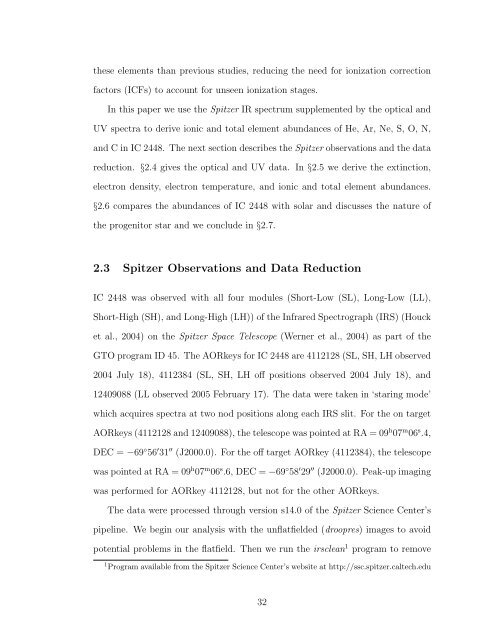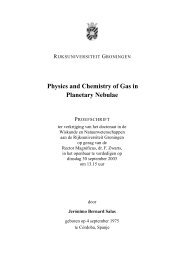TRACING ABUNDANCES IN GALAXIES WITH THE SPITZER ...
TRACING ABUNDANCES IN GALAXIES WITH THE SPITZER ...
TRACING ABUNDANCES IN GALAXIES WITH THE SPITZER ...
Create successful ePaper yourself
Turn your PDF publications into a flip-book with our unique Google optimized e-Paper software.
these elements than previous studies, reducing the need for ionization correction<br />
factors (ICFs) to account for unseen ionization stages.<br />
In this paper we use the Spitzer IR spectrum supplemented by the optical and<br />
UV spectra to derive ionic and total element abundances of He, Ar, Ne, S, O, N,<br />
and C in IC 2448. The next section describes the Spitzer observations and the data<br />
reduction. §2.4 gives the optical and UV data. In §2.5 we derive the extinction,<br />
electron density, electron temperature, and ionic and total element abundances.<br />
§2.6 compares the abundances of IC 2448 with solar and discusses the nature of<br />
the progenitor star and we conclude in §2.7.<br />
2.3 Spitzer Observations and Data Reduction<br />
IC 2448 was observed with all four modules (Short-Low (SL), Long-Low (LL),<br />
Short-High (SH), and Long-High (LH)) of the Infrared Spectrograph (IRS) (Houck<br />
et al., 2004) on the Spitzer Space Telescope (Werner et al., 2004) as part of the<br />
GTO program ID 45. The AORkeys for IC 2448 are 4112128 (SL, SH, LH observed<br />
2004 July 18), 4112384 (SL, SH, LH off positions observed 2004 July 18), and<br />
12409088 (LL observed 2005 February 17). The data were taken in ‘staring mode’<br />
which acquires spectra at two nod positions along each IRS slit. For the on target<br />
AORkeys (4112128 and 12409088), the telescope was pointed at RA = 09 h 07 m 06 s .4,<br />
DEC = −69 ◦ 56 ′ 31 ′′ (J2000.0). For the off target AORkey (4112384), the telescope<br />
was pointed at RA = 09 h 07 m 06 s .6, DEC = −69 ◦ 58 ′ 29 ′′ (J2000.0). Peak-up imaging<br />
was performed for AORkey 4112128, but not for the other AORkeys.<br />
The data were processed through version s14.0 of the Spitzer Science Center’s<br />
pipeline. We begin our analysis with the unflatfielded (droopres) images to avoid<br />
potential problems in the flatfield. Then we run the irsclean 1 program to remove<br />
1 Program available from the Spitzer Science Center’s website at http://ssc.spitzer.caltech.edu<br />
32













